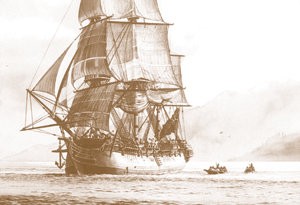3:7 Hyper-Linking GGRW Connections
Write a blog that hyper-links your research on the characters in GGRW according to the pages assigned to you.
PAGES: 107-120, 2007 Edition
I would like to start by saying that it is hard to get past the title Green Grass, Running Water without seeing Thomas King’s first reference to historical events. The title itself is a reference to the language found in many treaties, which promised the Indians that the land would be theirs “as long as the grass is green and the water runs.”
My first section introduces us to Latisha and the Dead Dog Café. Latisha, through the suggestion of her auntie, uses disempowering racialized imagery to make a living by creating a restaurant that claims to serves dog meat. She goes as far as recreating white colonial fantasies through fabricated postcards of “Indians” hunting and hoisting dogs as their catch of the day. She has her employees dress up, “Plains. Southwest, or combination?” trying to resemble the image that tourists would expect an “Indian” to look like. The fact that they use the idea of “combination” suggests that what tourists think an “Indian” should look like has nothing to do with reality and stems from the imagination of original colonizers. Old Agency is a Blackfoot settlement on the Blood Reserve near Lethbridge, Alberta and when turned into a stew, pokes fun at the idea of beef disguised as an authentic indigenous experience. King uses the Dead Dog Café as a way to mock western expectations allowing colonizers to consider it as confirmation that the stories are true; the “Indians” were “uncivilized savages.” I am left wondering if they are really fooled by Latisha’s insistence that they are eating dog meat or are they content with having their expectations filled by a stereotype with no substance? As mentioned in Jane Flick’s reading notes, the café name itself may refer to Nietzsche’s assertion that “God is Dead”, as you may recall earlier in the book when the dog mistakenly thinks he is God.
Next we are introduced to Eli Stands Alone and his standoff with Clifford Sifton and the Grand Baleen Dam. Both characters and the dam itself are historical references made by King. Eli is connected to Elijah Harper, the Oji-Cree politician, consultant, and policy analyst that stalled the Manitoba legislature past the deadline for approval of the Meech Lake Accord. Sifton is a direct reference to Sir Clifford Sifton, a Manitoba businessman who became the Federal minister of the Interior and Superintendent of Indian Affairs under Sir Wilfred Laurier. Sifton’s pro-immigration policies for white Europeans through the “Prairie West” movement was an enormous cost to First Nations peoples, who were displaced in large numbers. The Grand Baleen Dam refers to the Great Whale River Project that destroyed traditional Cree hunting grounds. It is also a close reference to the Oldman River Dam that is located in southern Alberta and intruded on sacred Native land owned by the Blackfoot Nation. In all of these cases, the choice to build a dam did not take into account the opinion of the First Nations or the negative impact they would have on the environment.
Last we meet Charlie Looking Bear who comes across as a materialistic, wannabe white, lawyer. This is reflected in the fact that he lives in Edmonton and King mentions the West Edmonton Mall, one of the world’s largest shopping malls. Although we read about Charlie’s love interest, we also find more historical references surrounding Eli’s battle with the dam. Charlie is employed by Duplessis International Associates as he was hired as a front man for their case against Eli Stands Alone. He is well aware that he was hired solely because he was Blackfoot and Eli was Blackfoot and this would make for good media. The name Duplessis refers to the political corruption of Maurice Duplessis, the once Prime Minister and attorney general of Quebec. He was known as a controversial leader that produced ambitious hydroelectric power schemes, extending electrification throughout rural Québec. After battling with Eli, Duplessis International Associates hires the PR firm Crosby Johns and Sons Inc., playing on the once Minister of Justice, John Crosbie who was involved in a patronage scandal that involved his sons being on the federal payroll.
In just thirteen pages of this fascinating book there are many references made by King that really challenge the reader to explore further into what is being read. With each reading and some research I was able to gain more and more knowledge about our country as well as the discourses we are taught to believe.
Works Cited:
“Cree Legal Struggle Against the Great Whale Project.” Grand Council of the Cree. n.p. n.d. Web. 30 March 2016.
“Elijah Harper.” The Canadian Encyclopedia. Historica Canada. n.d. Web. 30 March 2016.
“God is Dead.” Philosophy Index. Philosophy Index. n.d. Web. 30 March 2016.
“John Crosbie.” The Canadian Encyclopedia. Historica Canada. n.d. Web. 30 March 2016.
“Meech Lake Accord.” The Canadian Encyclopedia. Historica Canada. n.d. Web. 30 March 2016.
“Maurice Le Noblet Duplessis.” The Canadian Encyclopedia. Historica Canada. n.d. Web. 30 March 2016.
“Oldman River Dam.” University of Lethbridge. University of Lethbridge. n.d. Web. 30 March 2016.
“Sir Clifford Sifton.” The Canadian Encyclopedia. Historica Canada. n.d. Web. 30 March 2016.
“Thomas King Native Indian Writer.” 20th Century Native American Literature. n.p. n.d. Web. 30 March 2016.

